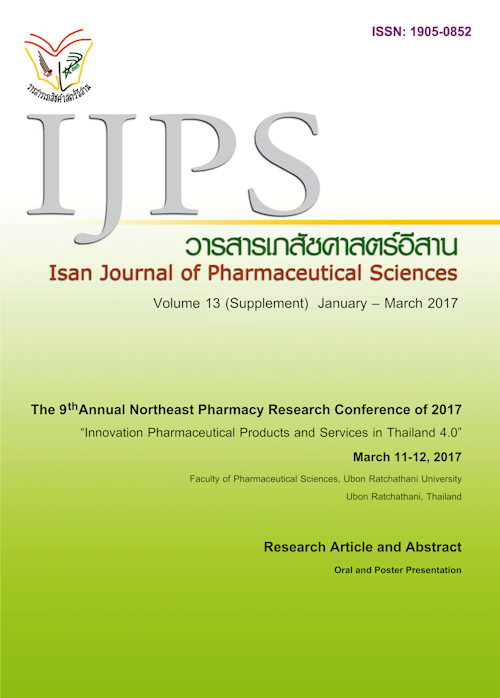The review articles about the investigation of medication problem in community: The important concepts and application
Main Article Content
Abstract
Introduction: There have been medication problems in communities in Thailand for a long time. Continuously, problem-solving activities have been implemented. However, there is too little success now. The objectives of this article were review articles about the investigation of medication problems in community in topic of methods and results. It was expected that this could assist readers get more understanding about the methodology and could apply it to their work. Methods: Use WHO guideline, Thai guideline and previous studies. Results: The World Health Organization proposed the process to investigate medicines use in communities which consisted of 7 steps as follows: (1)describe drug use and identify problems (2) prioritize problems (3) analyze problems and identify solutions (4) select and develop intervention (5) pretest intervention (6) implement intervention and (7)monitor and evaluate intervention. For Thai guideline, the processes are similar. However, it was added the preparation phase of researchers and emphasized the importance of economic and social factors in the context of community in addition to health factors. It also proposed the 7 tools that help working in community easier. The research examples illustrated the medication problemsin community and the method to solve problems in real situation. It was found that the researches which success in solving medication problemsin community covered all processes suggested by the guideline. The investigation of medication problemsis just a starting point of the problem-solving process. Conclusion: The operations which work systematic and systematically, participated from stakeholders, and consider the context of community could bring to the successful, help working people to understand their community and work happily.
Article Details
In the case that some parts are used by others The author must Confirm that obtaining permission to use some of the original authors. And must attach evidence That the permission has been included
References
Booddawong B, Tantawevong A, Sidala Y. Report essons: management issues drug sustainable communities: case study in nonkoon district sisaket province. Bangkok: Usa Printing; 2015.
Buranasiri W. Thailand's people eat a very high 47,000 million tablets per year. [Online]. 2012 [cited 2016 july 1] Available from:http://astv.mobi/AU9ggYu
Bureau of information of Thailand. The new media. [Online]. 2010 [cited 2016 july 1] Available from:http://pr.moph.go.th/iprg/include/admin_hotnew/show_hotnew.php?idHot_new=84841
Cheyoe N. Prevalence and risk factor for medication non-adherence in patients with type 2 diabetes mellitus. HSRI2013; 9(1): 74-79.
Chuengsatiansup K, Srinegenyuang L, Paonin V. Drug and communities: Social and cultural dimension. Bangkok: D one books; 2007.
Chuengsatiansup K,Trangrang K, Pinkaew R, Petchkong W. Lifestyle community: study guide that makes it easy and fun. Nonthaburi: Desire; 2002.
Hardon A, Hodgkin C, Fresle D. how to investigate the use of medicines by consumers. Switzerland: World health organization and University of Amsterdam; 2004.
Hardon A, Jakobowicz PB, Reeler A. How to investigate drug use in community : Guideline for social science research.Geneva: World health organization; 1992.
Lomas K, Chanthapasa K. The Situation of Radio Advertisement of Drug and Food Claimed as Drug in Phraibueng Municipality, Sisaket Province. IJPS2012; 8:55-60.
National Statistical Office of Thailand. Annual report 2014. Samut Prakan: Udomsuksa Printing and Publishing; 2015.
Phonyiam S, Kaewbuapan T, Chadmuk P, Sangguanrat S. Distribution of inappropriate drug use in community, Phonthong, Roi l Et.Phonthong: Phonthong hospital; 2016.
Pimdee A. Post marketing surveillance of inapprotiated distributive drug in Khon Kaen province. Khon Kaen.Thai Academic centers, surveillance and drug development; 2015. 58-00-0331.
Plengchai S. The solution ofinappropriate drug distribution in community, Roi l Et:Selaphum: Thai Academic centers, surveillance and drug development; 2011. 52-00-0360.
Tharat N, Limwattananon C, Sakolchai S, et al. Monitoring and evaluating the implementation of Non-essential drug prescription criteria measure at a Provincial Hospital in Thailand. Hsri2014; 8(3): 221-229.


